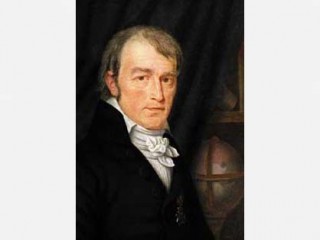
Johann Friedrich Von Bohnenberger biography
Date of birth : 1756-06-15
Date of death : 1831-04-19
Birthplace : Simmezheim, Germany
Nationality : German
Category : Science and Technology
Last modified : 2010-05-28
Credited as : Physicist and mathematician, the Bohnenberger electroscope,
0 votes so far
Johann Gottlob Frederick von Bohnenberger was born on June 15, 1765, in Simmezheim, Germany. His father, Gottlieb Christoph Bohnenberger, was a minister and he made some study in electricity. Frederick studied theology in Tubingen, and in 1789 he became a priest.
However, he went to study mathematics and astronomy first to Zach and then to Gottingen. Since 1796 he was an assistant at the Tubingen observatory and from 1803 professor of mathematics and astronomy there. In 1811 Frederick von Bohnenberger published a book, the “Astronomy”, which made him well known. From 1818 up to his death he was a chief inspector of munitions in Wuttenberg.
Frederick von Bohnenberger made important contributions to the study of electricity. He made electrostatic machines and Bohnenberger electroscope that was an important electrometric instrument.
This curious machine is a primitive influence (electrostatic) machine, proposed by Bohnenberger in 1798, as a rotating implementation of Bennet’s doubler (1787, used as an electromer).
About 1814 J.F.G. von Bohnenberger suggested a form of electroscope in which the single leaf was attracted to one of two conductors placed symmetrically on either side of it. The conductors were, in turn, connected to the two poles of a dry pile, thus allowing the sign of the charge applied to the leaf to be determined.
The Bohnenberger electroscope comprises two batteries connected by a common base producing a constant potential difference of the order of 1000 volts. The free terminals have two small brass spheres. The unit is mounted in such a way that these two spheres have symmetrical electric charges. A piece of gold leaf suspended on the stem of the electroscope is attracted by the sphere of one of the batteries when an electrically charged body is brought close to the electroscope.
It is thus possible, with this electroscope, to determine the nature of the charge of an electrically charged body. To do so, the charges on the spheres should first be known; this can be ascertained by observing the behaviour of the gold leaf when the electroscope is influenced by a body whose electrical charge is known.
However, Bohnenberger’s main interests were in the fields of geodesy and geophysics. Bohnenberger and Soldner were the pioneers of the German geodesy. Bohnenberger has constructed a gyroscope. The gyroscope in the form we know it today was invented in 1852 by Leon Foucault.
However, it had an ancestor in the device developed by Johann von Bohnenberger in 1817. Napoleon I was so much impressed by this device that he recommended to introduce it in French schools.
The construction and operation of the Bohnenberger’s gyroscope are discussed in the 1856 first volume of Benjamin Pike, Jr.’s Illustrated Descriptive Catalogue of Optical, Mathematical and Philosophical Instruments: “Bohnenberger’s Machine.
This apparatus consists of three movable rings, …, mounted on a stout base. The two inner rings are mounted on pivots; those on the smallest ring at right angles to the middle one; in the smallest ring is supported a metal ball, having a roller on one of its pivots; around the roller a string may be wound, and when pulled off a rapid rotary motion may be given to the ball.
This motion may be given with the axis in any position required, and when communicated, the ring supporting the ball will resist considerable effort to alter its position, and whatever way the instrument may be turned, its axis will continue to maintain the position it had when set in motion, illustrating the inertia, or that property of matter which resists any change of state, whether of rest or motion.”
Bohnenberger died on the 19 April 1831 in Tubingen.
















